Because of seemingly overwhelming cultural differences, the prospect of traveling to the Middle East is often not considered a viable travel option to many. Those who do take the plunge often opt for an easier, softer intro to the area with a brief layover in Dubai or an all-inclusive vacation package, where the cultural milieu of the Arab world is kept at bay and you can parade in your bikini and speedo without worrying about cultural sensitivity.


What You Can and Can’t Wear in the Arab World as Travelers
Sidestepping these two extremes to experience something truly authentic and spontaneous, while being modestly but stylishly attired, isn’t nearly as difficult as travelers imagine. Just as a few insights into Arab customs and clothing styles help you feel respectful, safe, and welcomed into a local community.
Every Arab country is different in terms of clothing norms, but the common thread among them all is Islam and the special emphasis the religion places on modesty in dress and behavior. The areas covered here include hot spots on the tourist trail for travelers to know what they can and can’t wear in Morocco, Tunisia, Lebanon, Jordan, Turkey, Qatar, the UAE, and Oman.
-
- Morocco
- Tunisia
- Turkey
- Lebanon
- Jordan
- United Arab Emirates
- Oman
- Qatar
Morocco
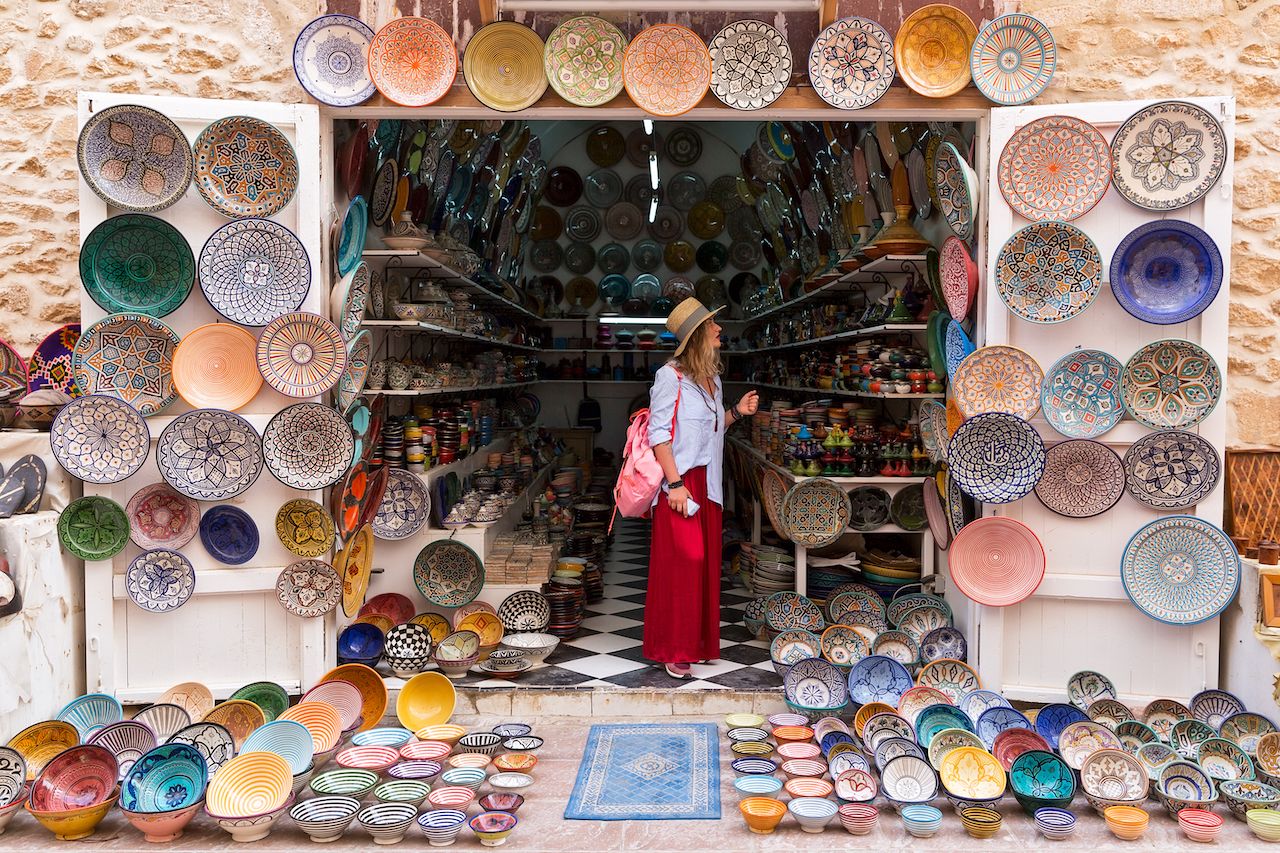
Photo: Yudina_Elena/Shutterstock
While Morocco is predominantly Muslim, it is one of the most occidental-oriented countries in the Arab world. With its proximity to Europe, geography has certainly played a role in fostering this country’s liberal outlook, but what has really made the difference is the fact that, ethnically and culturally, it is Berber at heart.
The indigenous Berber culture, with its traditions of democratically run village councils and women’s rights — no head veil required, freedom to marry who they please, and even annual festivals in the Atlas Mountains where wives could divorce their husbands and enter into new relationships — established a relaxed fashion sense on both the streets of its cities and in the corridors of power where you’re just as likely to see a Muslim cleric in traditional robes as you are a woman wearing the lastest trends.
As a traveler, this means there are many clothing options. The more traditional one (for both men and women) is a local djellaba, a robe-like garment with a hood popular in the Maghreb. If you’re a George Lucas fan, the Moroccan djellaba might remind you of the cowl the Jawas from Star Wars wore on the desert planet of Tatooine. Scoring a dark-brown one (similar to those seen in the movies) made my inner sci-fi nerd ecstatic and simultaneously covered up my American uniform of shorts and a T-shirt — blending in and geeking out at the same time.
While some of the female travelers in Marrakech go the same route by purchasing either a djellaba or a kaftan (basically a more ornate djellaba minus the hood) to cover up and be done with it, most tend to take their clothing cues from the more modern Moroccan ladies — lots of loose tunics paired with leggings, jeans, and long, flowy skirts. A scarf, for comfort and modesty sake, is a must. And while you can wear shorts and tank tops when you’re out and about, you’re likely to get dirty looks from every gender on the spectrum. Swimming suits outside of resorts are not strictly haram (forbidden) but a one piece rather than a bikini is better if you don’t want to attract too much attention. Keeping a cover-up with you for the beach is also a good idea but no matter how humbly you dress wherever you are, women shouldn’t be surprised to get a marriage proposal or two — it’s the Moroccan way of flirting. And if you’re too shy, a faux wedding ring may help discourage any would be Lothario.
Tunisia
The most liberal minded-country in the region is Tunisia. Because the country has been a pioneer in women’s rights since 1956, when polygamy was outlawed and the right to file for divorce was granted to women, along with a host of other basic human rights, such as traveling without the permission of a husband, giving their children their last names, and marrying non-Muslim men without forcing them to convert, women can wear whatever they want without fear of reprisal by the morality police — even bikinis on the beach are allowed. What is not allowed for security reasons is the niqab — the full face veil that reveals only the eyes. Following three suicide bombings in the space of a week in the capital of Tunis in 2019, all face-obscuring veils have been temporarily banned in government buildings until a normal security situation returns.
The most secure and libertarian areas are in the big cities of Tunis, Marsa, Sidi Bou Said, Hammamet, Sousse, and Djerba. Travelers also have more freedom to dress as they please in the bigger cities and less so in the smaller ones or in the countryside, which are usually more conservative.
Turkey
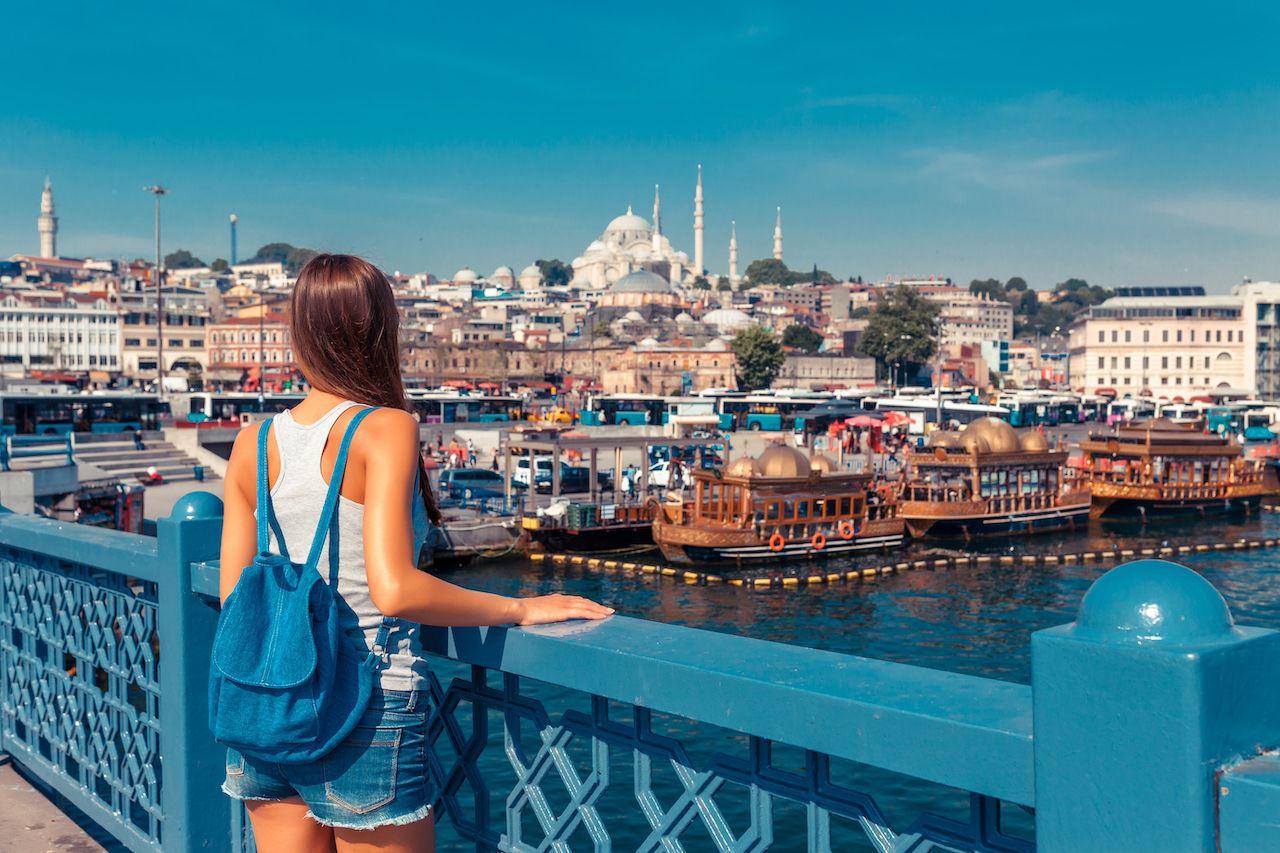
Photo: Oleg_P/Shutterstock
In Turkey, the scene can change from holy to historic to hedonistic faster than you can say Istanbul was once Constantinople. That being the case, keep your swimwear, scarf, and little black dress (a collared shirt and blazer for the guys) handy as you dive into the warm, clear waters of the Aegean Sea in the morning, stroll the colonnaded and cobblestoned streets of the ancient Roman ruins of Ephesus in the afternoon, and in the evening, shake what your mama gave you at one of the trendy nightclubs in the cosmopolitan capital. As always, the bigger the city, the more relaxed the dress code tends to be, especially in Istanbul and Izmir — Ankara is considered more conservative.
Lebanon
Lebanon is a mixed bag. While visiting a friend in Beirut, I saw two fashion extremes side-by-side at a shopping center — one local woman was dressed in an abeyya, a long, flowing black gown topped by a niqab. In stark contrast stood another Lebanese woman right next to her, wearing high heels; tight-fitting, ripped blue jeans; and a cropped, backless blouse. They commingled peacefully in this case, both more interested in finding a bargain than in each other’s outfits.
The ultra-chic scene of high heels and bikinis, poolside bars, and international DJs at one of the many swimming clubs is culturally a world away from Dahieh, a predominantly Shia neighborhood and Hezbollah stronghold but geographically just a few miles in distance. In Beirut, if you plan to do any exploring at all, it’s best to carry your swimsuit and a scarf in your daypack because you’ll probably need them both. If you’re not sure of the vibe of the neighborhoods you’ll be in, just inquire with your hotel or ask a local.
Jordan

Photo: Zephyr_p/Shutterstock
In Jordan, certain places can be cosmopolitan and open-minded, like Rainbow Street, an entertainment district popular with locals and foreigners in Amman. However, the country is, as a whole, fairly conservative. Although you can dress as provocatively as you’d like, the more you show, the more unwanted attention you’re likely to get. While certainly not always the case, the unfortunate mentality in Jordan toward women seems to be the tighter the clothes, the looser the morality. Dress accordingly, with longer skirts and pants, and avoid tank tops and shorts, to remain unbothered and safe.
United Arab Emirates
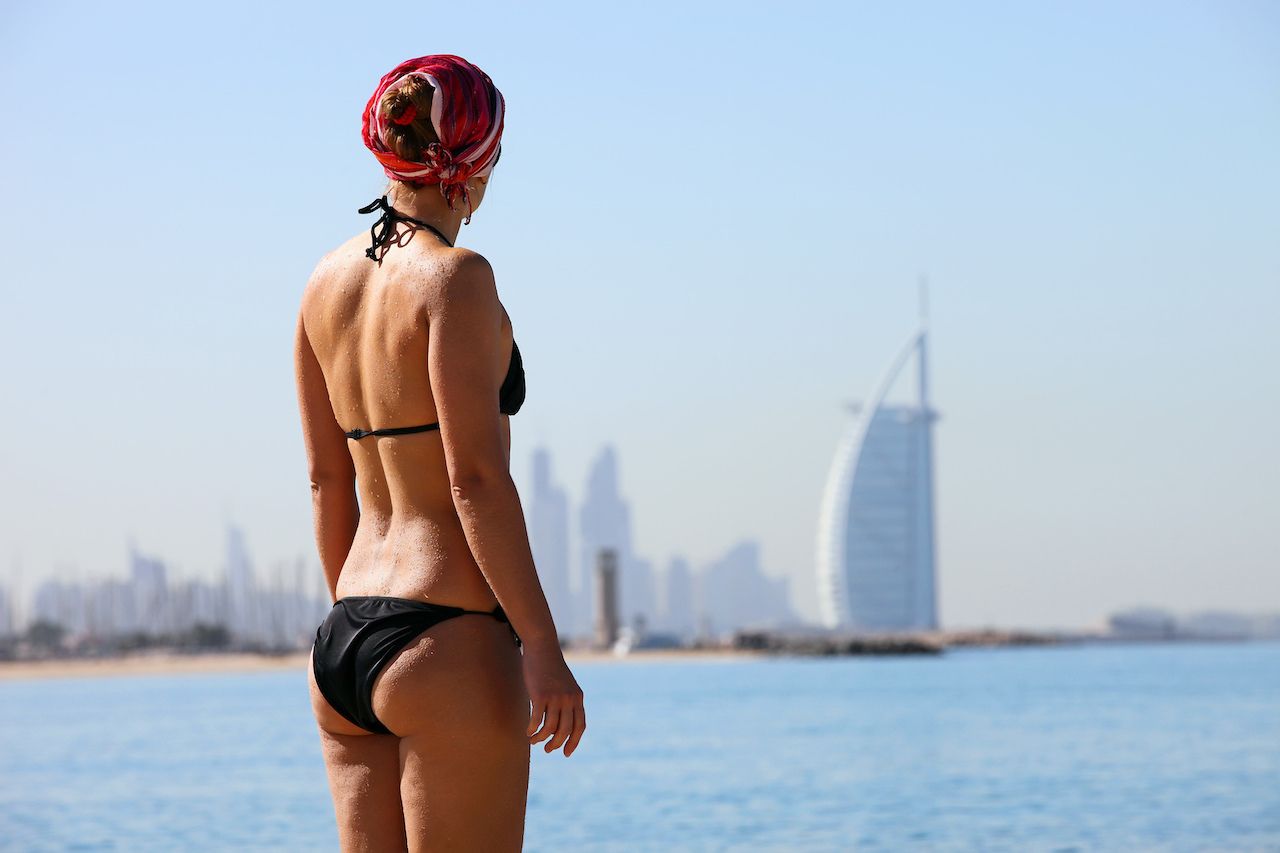
Photo: Photobac/Shutterstock
In the UAE, where Dubai is located, you will inevitably find yourself in a mall. Whether it’s for snowboarding or swimming with sharks or even something as banal as shopping, you will not have experienced the Emirati lifestyle until you’ve set foot in one of its shopping centers like the Dubai Mall or the Mall of the Emirates. While you’ll see signs posted at the entrances that say “respectful clothing” is required — meaning no short shorts, bare shoulders, or miniskirts — pretty much anything goes as far as fashion is concerned because of the expat majority (85 percent foreign, 15 percent local). From women in skin-tight dresses and stilettos to Emirati grandmothers in black abeyyas and burqas (a type of local facemask made with metal and indigo), you’ll see it all in the malls in Dubai.
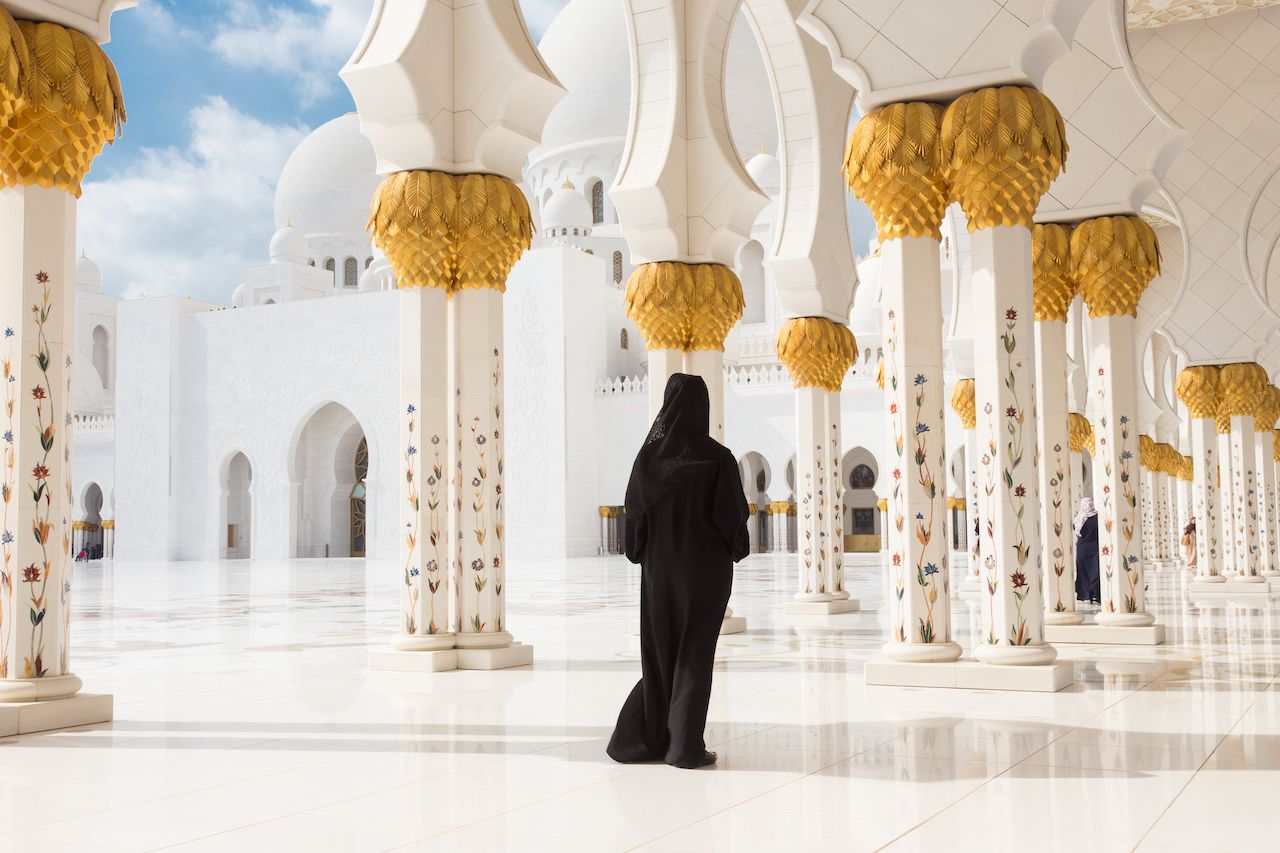
Photo: Matej Kastelic/Shutterstock
Outside of the Dubai bubble, however, this is definitely not the case. Nevertheless, if you inadvertently violate the dress code, you’re much more likely to just get stared at more than usual rather than asked to leave — no morality police here roaming about looking for troublemakers. The same goes for “respectful clothing” beaches. If you want to sunbathe in something more revealing than a burqini, just look for the signs. If there aren’t any, you’re in the clear. If all of the beaches in your area require “respectful clothing” and you’re dying to work on your tan lines, head to any major hotel on the sea and you will more than likely find a place to sun your buns and swim as you please (but definitely not topless).
Topping your list of places to see in the UAE should be Sheikh Zayed Mosque in Abu Dhabi. Shorts or skirts should reach below your knees and your shoulders should be covered. For those who can’t be bothered, the mosque does have loaner abeyyas and shaylas, Islamic headscarves, for women and kanduras, white long-sleeve shirt dresses, for men.
For women, having their own abeyya and shayla combo in their daypack while in the Middle East will make life a lot easier — especially when visiting sites of religious significance or when the inevitable staring gets to be too much. While this may be good advice for the goose, it’s not so for the gander, unfortunately. In the UAE, it is actually heavily frowned upon for anyone except local men to wear a kandura.
Oman
With a little tact and discretion, you should have no problem avoiding any clothing faux pas in the Sultanate of Oman, a fascinating, but often overlooked corner of the Arabian Peninsula that is very welcoming to travelers. In the five years that I lived there, there was only one incident when I was trying to renew my car registration at a police station in the capital of Muscat that I was asked to leave because I was wearing shorts. So if you must conduct any government business, don’t wear shorts, or keep a sarong (known locally as a wazar) in your daypack to cover up if need be.
Not only is a wazar or sarong convenient to cover up, it can also be highly functional as a beach blanket if you find yourself along some of the 1,060 miles of coastline in Oman. Outside of the beach resorts, bikinis and short shorts will draw a crowd and a possible citation from the Tourist Police. Women should swim in a T-shirt and leggings combo to be on the safe side in public areas. For men, boardshorts are acceptable. Elsewhere, both ladies and gentlemen should go light and loose with cotton, chambray, and linen — covering shoulders and knees.
While it’s cool for foreign men to sport a kummah, an embroidered Omani cap, they should definitely not wear a dishdasha. Like the Emiratis, the Omanis are sensitive about their national dress. Even if it is worn out of respect, it could easily be assumed that you are mocking them.
Qatar
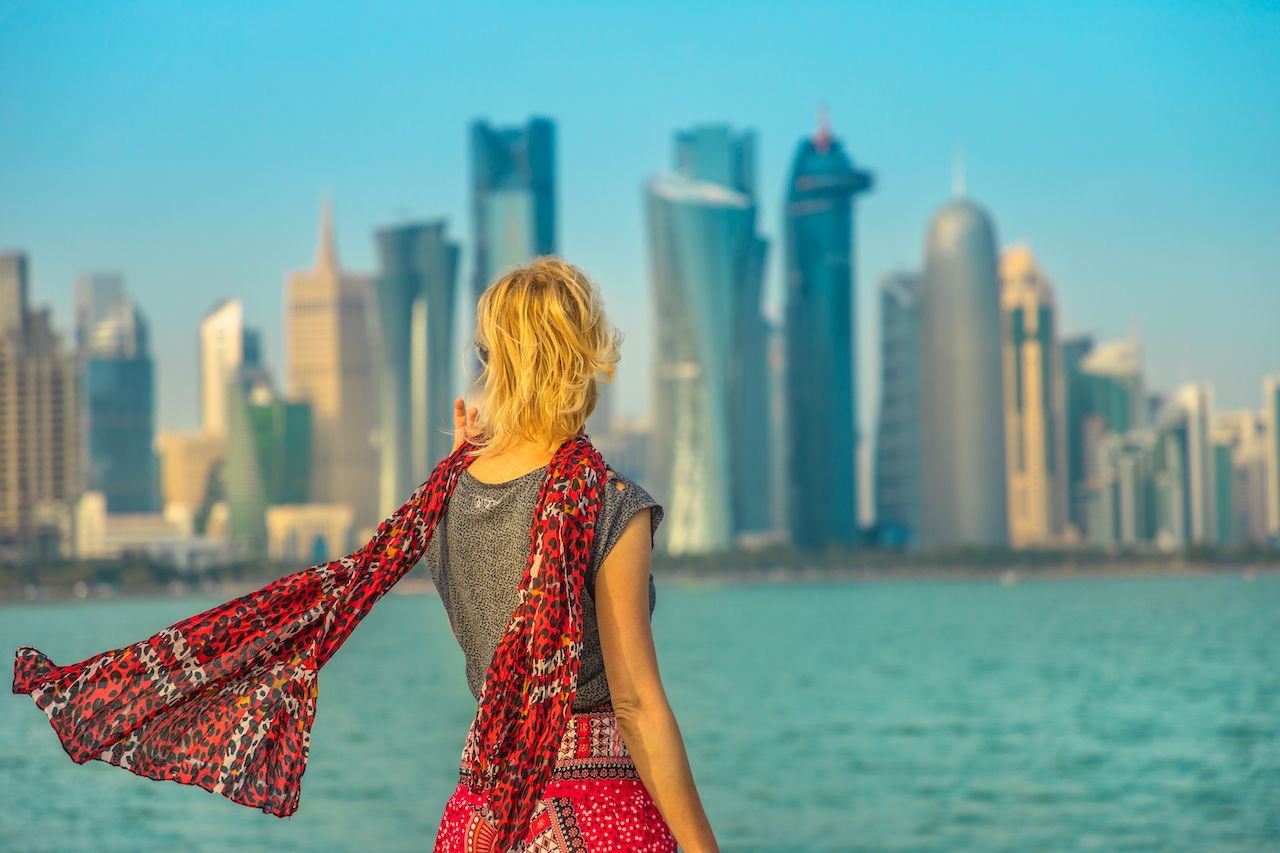
Photo: Benny Marty/Shutterstock
What is considered disrespectful dress in Oman is also considered disrespectful in Qatar. In shopping malls, souqs, and along the waterfront promenade — basically all public spaces including public beaches — bare shoulders are a big no-no as are any skirts, shorts, or dresses above the knee. In hotel and resort areas, however, Western standards of dress and poolside attire apply. Outside of these areas, tank tops and singlets are actually fine as long as you cover up with a scarf or a pashmina. The key to covering up and staying cool in the Middle East is choosing breathable fabrics, so pack cotton, linen, and silk. To keep the airflow going in your footwear, wear sandals, cotton tennis shoes, or netted runners. Don’t forget a cardigan because like most countries in the Gulf Country Council, the Qataris like to keep the temperature inside just above freezing.